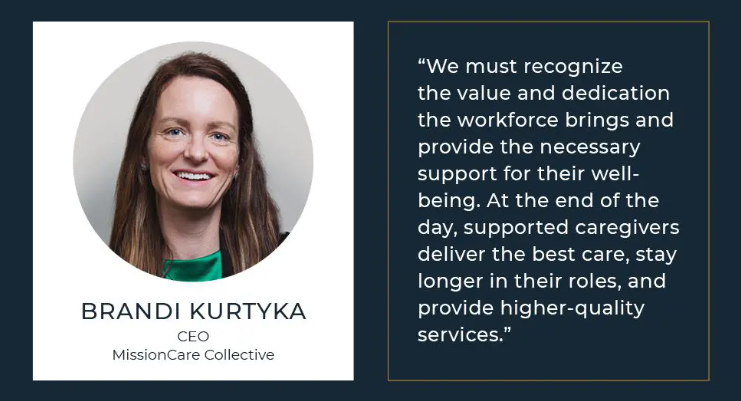
Nursing homes have weathered the storm of a two-and-a-half-year pandemic wrought with infection control management, increasingly strict regulations and guidelines, and declining staffing patterns. Progress has been made on many fronts yet staffing remains a massive challenge for operators aiming to achieve quality patient outcomes and above average star ratings while maintaining fiscal responsibility.
To further explore this issue, that is top of mind for operators across the nation, we sat down with MissionCare Collective’s CEO Brandi Kurtyka to discuss some of the struggles and opportunities that arise in the recruitment and retention of frontline caregivers and certified nursing assistants (CNAs), a vitally important workforce. Serving approximately 8,000 senior living providers and partners across the nation, MissionCare Collective is a mission-driven organization operating two key recruitment and retention brands in the industry: myCNAjobs, which connects over three million caregivers annually to training and resources; and CoachUp Care, an engagement platform helping providers reduce turnover through a unique framework.
The Challenges are Immense
“The challenges of hiring frontline caregivers in assisted living and skilled nursing facilities are complex and multifaceted,” Kurtya said. “The industry is constantly grappling with issues such as staff shortages, high turnover rates, burnout, and inadequate training. This, in turn, is severely impacting the quality of care our seniors receive.”
The biggest factors contributing to staffing challenges, according to Kurtyka, begin with the fact that the pool of workers is too small.
“A rapidly aging population and increased life expectancy have led to a higher demand for workers than currently exist today,” she pointed out. “However, the number of available CNAs has not kept pace with the demand, leading to staff shortages in many communities.”
Compound that with the trend of exhausted healthcare workers leaving for other industries, and the problem gets worse. “I see more people leaving the profession than entering. This is a problem we need to solve,” Kurtyka said, adding that high turnover rates and unengaged employees continue to plague the industry.
“The dirty little secret of our industry is high turnover, which we all know leads to inconsistent care or the inability to deliver care at all. Working as a caregiver is a tough job. It’s God’s work,” added Kurtyka. “People are certainly not doing this work for the pay and we see many companies trying to recruit their way out of a retention problem.”
Raising wages and better engaging staff is a must to stabilize the workforce, she added.
“The average hourly wage for a CNA or frontline caregiver in most states typically has a notably poor competitive wage index score, meaning that someone with similar or fewer skills can earn more in another profession.”
Better Understand the Workforce
Beyond raising pay and improving benefits, solving the workforce crisis really starts with understanding the people behind delivering care, Kurtyka believes.
“We must recognize the value and dedication the workforce brings and provide the necessary support for their well-being,” she adds. “At the end of the day, supported caregivers deliver the best care, stay longer in their roles, and provide higher-quality services.”
As part of its ongoing efforts to understand caregivers to best support them, MissionCare Collective conducted an analysis of 67,000 direct care workers and used the findings to outline seven caregiver personas reflecting the faces of a frontline employee working in care today. The seven personas as described in “The State of The Direct Care Workforce” report include:
- Career Caregivers. Having worked in the profession for at least three years, this group most likely doesn’t have a second job and desires full-time hours. Benefits for the employer include stability and interest in career growth.
- Caring on the Siders. Wages, flexibility, and opportunities to make a difference are key elements for this group.
- Young and on the Move. This category is seen as eager to work and learn, however they require that their work enhances their life. Living by an inverse of the classic creed, this group “works to live.”
- Oodles of Offspring. This group needs flexibility but also desires pathways to learn, grow, and gain more skills.
- Single Moving Mommas. A family-oriented culture and access to special programs and benefits may be especially appealing to this cohort.
- Empty Nesters. This group values a consistent schedule and a great client match.
- Still Going Strong Retirees. In addition to earning extra money, this group appreciates the opportunity to serve other people and do good in their community.
“Many organizations take a one-size fits all strategy, but there’s an opportunity to open your pipeline by targeting each group and customizing your approach, incentives, and benefits accordingly,” Kurtyka suggested. Personas play a key role in those efforts. “Further, personas help inspire fresh thinking to create strategies that are most likely to align with various groups.”
Engage Your Team
Leadership at any company would like to believe their team is satisfied and fulfilled, yet the reality can sometimes tell a different story. Working as a caregiver is hard work and there is a high burnout rate, according to MissionCare’s data. Further, many organizations spend too much time and effort focused on training for compliance as opposed to helping employees forge their career path.
At the end of the day, Kurtyka mentions that addressing the workforce challenge is a collective effort and that everyone must work together diligently to ensure people can get the care they deserve.
“The art and science of employee engagement is getting people connected to each other, the company, and your mission,” concluded Kurtyka. Doing so is not easy, but the rewards of an engaged, effective, and fully staffed workforce are well worth the effort. “We’re starting to help providers chip away at this with the CoachUp Care framework and the results we’re seeing of bringing a disconnected workforce together are inspiring,” she concluded.
Brandi Kurtyka is a national speaker and CEO of MissionCare Collective, the parent company of myCNAjobs and CoachUpCare.
